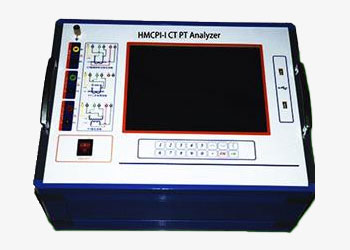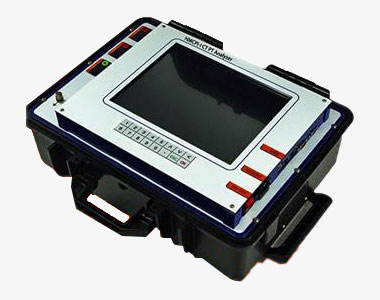Current transformer CT PT analyzer with backlit LCD screen, turns ratio measurement range 1~30000, CT secondary load measurement 0~160 ohm, PT secondary load measurement 0~80 ohm, current transformer tester can store 2000 groups test data and can be stored in a computer with a USB flash drive.

Current Transformer Testing
- Excitation curve parameter test
- Turns ratio test
- Ratio and phase error testing
- Polarity mark check
- Coil resistance measurement
- Transient CT parametric test

Voltage Transformer Test
- Excitation curve test
- Turns ratio test
- Polarity test
- Secondary burden test
- Coil resistance Test

Applications of CT PT Analysis
- CT parameter inspection workload
- CT Transient parameter analysis
- CT ratio and phase error calibration
- PT routine test
Application
The current transformer tester adopts a high-speed and high-reliability digital processing module, which meets the requirements of a high-power output power test and is convenient for testers to use and carry. The sisco current transformer tester can be used in harsh environments such as high temperature, high humidity, sea, desert, extreme cold, and high altitude.
| Model | SISCO-CT-HM404 | ||
| Input Voltage | AC220V, 50Hz/AC110V, 60Hz | ||
| Usage | Class P/TP CT & VT | ||
| Power Output | 500VA | ||
| Maximum Knee Voltage Measurement | 45 kV | ||
| Voltage Output | 0.1~180V (AC) | ||
| Current Output | 0.001~5A(RMS) | ||
| Current Measurement | Range | 0~10A (Automatically change range in 0.1/0.4/2/10A) | |
| Error | <±0.1%+0.01%FS | ||
| Voltage Measurement | Range | 0~200V (Automatically change range in 1V/10V/70V/200V) | |
| Error | <±0.1%+0.01%FS | ||
| Turns Ratio Measurement | Range | 1~5000 | 5000~35000 |
| Error | <0.05% | <0.1% | |
| Phase Measurement | Range | ±2min | |
| Resolution | 0.01min | ||
| Winding Resistance Measurement | Range | 0~8kΩ (Automatically change range in 2ohm/20ohm/80ohm/800ohm/8kohm) | |
| Error | <0.2%RDG+0.02%FS | ||
| Maximum resolution | 0.1mΩ | ||
| Temperature Measurement | -50~100 Celsius degree | ||
| CT Secondary Burden | Range | 0~160ohm (Automatically change range in 2ohm/20ohm/80ohm/160ohm) | |
| Error | <0.2%RDG+0.02%FS | ||
| Maximum resolution | 0.001ohm | ||
| PT Secondary Burden | Range | 0~80kohm (Automatically change range in 800ohm/8kohm/80kohm) | |
| Error | <0.2%RDG+0.02%FS | ||
| Maximum Resolution | 0.1ohm | ||
| PT Ratio Measurement | Range | 1~10000 | 10000~35000 |
| Error | <0.1% | <0.2% | |
| PT Ratio Error Measurement | Typical Error | <0.05% | |
| Maximum Error | <0.1% | ||
| PT Phase Angle Measurement | maximum Error | <3min | |
| Memory Capacity | >1000 Groups Test Results | ||
| Working Condition | Temperature: -10℃~50℃ | Moist: ≤90% | |
| Dimension | 485*356*183mm | ||
| Weight | 15kg | ||
Q1: What is a current transformer analyzer?
A1: Current transformer analyzer is a multi-functional field test instrument specially designed for testing voltammetric characteristics, ratio, polarity, error curve, inflection point calculation, and secondary side circuit check of transformers.
Q2: How to use the current transformer analyzer?
A2: In the experiment, just set the test voltage and current values, and the device can automatically boost voltage/flow, and can quickly display the volt-ampere characteristic curve of the transformer or the experimental results of the ratio and polarity, etc. It supports data saving and on-site printing. sisico current transformer analyzer not only eliminates the tedious labor of manual voltage regulation, manual recording, and curve drawing but also allows you to upload the test data to your computer through the USB interface on the computer for editing, saving, or printing. It is simple and convenient to operate and improves working efficiency.
Q3: How to judge the polarity of the current transformer?
A3: There are many ways to measure the polarity of current transformers, and we often use the following three test methods in our work: the DC method, the AC method, and the instrumentation method.
Tips: How to measure the polarity of CT?
- DC method
Connect the positive terminal of the dry cell or battery to the primary winding P1 of the CT, and the negative terminal to P2. S1 of the secondary side
of the CT is connected to the positive terminal of the pointer ammeter (or the pointer multimeter to milliamp gear), and S2 is connected to the negative
terminal. After connecting the line, if the switch S in the moment of closing the pointer positive bias, pulling the instantaneous pointer reverse bias,
then P1, S1 is the same name end, the current transformer is minus polarity, such as the pointer swing with the above opposite for plus polarity. - Instrumentation method
The instrumentation method mainly uses a current transformer tester to determine the polarity of the CT, which adopts a constant voltage source
internally, has a wide measurement range, is easy to carry, and can not only visually display the CT polarity and ratio value, but also measure the
direct resistance and excitation characteristics of the CT, which is simple and intuitive, and is widely used at present.
Thank you for buying industrial test and measurement equipment on SISCO.com, all products sold by SISCO and the partner cover a 12 months warranty, effective from the date of receiving the products.
What is covered?
SISCO is responsible for providing free spare parts, and free technical support to assist the customer to repair the defective products until the problem is solved.
What is not covered?
- Product purchased from anyone other than a SISCO store or a SISCO authorized reseller.
- Expendable parts.
- Routine cleaning or normal cosmetic and mechanical wear.
- Damage from misuse, abuse or neglect.
- Damage from use of parts other than SISCO approved.
- Damage from use outside the product’s usage or storage parameters.
- Damage from use of parts not sold by SISCO.
- Damage from modification or incorporation into other products.
- Damage from repair or replacement of warranted parts by a service provider other than a SISCO authorized service provider.
- Damage caused by the application environment not meeting the product usage requirements and the failure to perform preventive maintenance.

